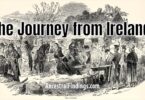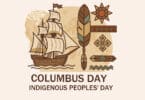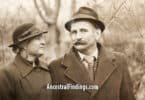Every year on October 31, children walk door to door collecting candy while wearing costumes. The custom feels old and familiar, but it has a real history. Trick or treat did not appear overnight. It grew slowly, shaped by the lives and traditions of many families who came to America from other countries.
For genealogists, this story adds useful background to family history. It helps date family photos, record memories, and understand how communities changed over time. This article follows trick or treat from its earliest roots to the way families still enjoy it today.
Where It Began
The earliest roots of Halloween reach back to seasonal customs in Ireland, Scotland, and parts of England. Long before the United States existed, families marked the end of harvest and the beginning of winter. They gathered for food, lit fires for warmth and safety, and remembered loved ones who had passed away.
As time went on, church days called All Saints’ Day and All Souls’ Day were added to this same season. The old and new blended together. People visited homes to offer prayers or sing in exchange for small cakes or food. In Scotland, this practice was called “guising.” In England and Ireland, it was known as “souling.”
Souling: It was believed that each soul cake eaten would release a soul from purgatory.
Guising: People wore masks and costumes to disguise themselves as spirits, allowing them to blend in with any malevolent souls and stay safe.
Arrival in America
Irish and Scottish immigrants brought these customs to the United States during the 1800s. They settled in both large cities and small towns, sharing traditions that soon mixed with local harvest events. Halloween became a time for children to dress up, play lighthearted pranks, and enjoy sweets or small gifts.
By the early 1900s, American families were adding their own touches. Children in costume went door to door, receiving fruit, nuts, or coins. The event did not yet have the name trick or treat, and not all towns took part, but the custom was taking shape.
When the Phrase Appeared
The words “trick or treat” first appeared in Canada around 1917. In the United States, the phrase began showing up in newspapers by the late 1920s. A Michigan article from 1928 described children calling out “tricks or treats.”
During this period, Halloween was still known for pranks. Young people soaped windows or moved yard gates, which caused problems for homeowners. To reduce the mischief, towns encouraged families to give children small treats instead. This made Halloween a friendly, community event that brought families together.
The War Years and After
World War II brought sugar rationing, and candy was hard to find. Families gave fruit or homemade snacks to children who came to the door. After the war, things changed quickly.
When peace returned, candy became widely available again. Suburban neighborhoods grew, filled with young families and children. Homes were close together, and sidewalks made walking safe. Parents felt comfortable letting children visit nearby houses. By the 1950s, trick or treat had become a regular part of American life.
How It Spread
Through the 1950s and 1960s, trick or treat became common across the country. Television shows and magazines showed children in costumes carrying bags of candy. Candy makers created smaller, individually wrapped pieces to sell for Halloween. Porch lights became a signal that a home welcomed visitors.
Some towns made local changes. A few held “Beggars’ Night” on October 30 to give children their own evening. Others set afternoon hours for safety. Every place did it a little differently, but by the end of the 1960s, trick or treat had become a familiar sight throughout America.
Homemade Treats and Store Candy
In earlier years, families handed out homemade cookies, apples, and popcorn balls. By the 1970s, more people preferred store candy because it was quicker to prepare and safer for large crowds. By the 1980s, wrapped candy had become the standard treat for trick or treaters.
If you study old family photos, this shift can help you tell when the picture was taken. Homemade goodies suggest the 1950s or 1960s. Plastic pumpkins and bags of wrapped candy usually point to the 1970s or later.
Why Genealogists Should Care
Halloween customs provide useful clues for family history research. They show how people lived and what their communities were like at different times.
Interviewing Family Members
Ask older relatives about their childhood Halloweens. Find out what they wore, where they went, and what they received. The type of treat or costume often helps date the story.
Using Old Photos
Look closely at Halloween pictures. Homemade costumes made from old clothes usually mean early 1900s through the 1940s. Store-bought boxed costumes and thin plastic masks often mean the 1950s and 1960s. Plastic buckets and name-brand candy appear in later decades.
Checking Local Records
Search town newspapers and newsletters for early mentions of trick or treat. Some towns listed official hours. Others announced parades, parties, or contests. These short notes show when the tradition reached your area.
Community Life
For families who arrived from other countries, taking part in trick or treat showed how they joined in American customs. Small moments like greeting children at the door show how a family became part of its community.
A Small Town Memory
In small West Virginia towns, trick or treat had a special charm. I remember my mom and dad driving me through different parts of our little town. They parked and let me walk through quiet neighborhoods while the air was cool and the porch lights glowed.
I carried my bag from door to door, hearing the laughter of other children nearby. One year I realized that my schoolteacher lived right there in town when she handed me Tootsie Rolls with a smile. Those nights were full of simple fun, familiar faces, and a safe sense of community that has always stayed with me.
This kind of memory reminds us why these traditions matter. They show how family, neighbors, and shared events link generations together.
A Useful Timeline
Before 1900
European customs such as souling and guising take place. Immigrants later bring them to America.
1900–1920
Costumed visits begin appearing in some towns. Treats are fruit, nuts, or coins.
1920s–1930s
The phrase “trick or treat” appears in North American newspapers. Communities organize friendly events.
1940s
War rationing limits sugar and candy. Families continue with fruit and homemade treats.
1950s–1960s
Candy companies promote Halloween. Suburban life helps spread the tradition.
1970s–1980s
Wrapped candy replaces homemade snacks. Costumes are colorful and often store-bought.
1990s–Today
Newer forms such as “trunk or treat” appear, but the main idea stays the same—children visiting homes and collecting candy in safety.
How to Use This Information
- Record family memories. Ask older relatives about their earliest Halloweens.
- Organize photos. Label each one with the year, costume details, and location.
- Search newspapers. Find the first local mention of trick or treat or a Halloween parade.
- Create folders. Keep stories, clippings, and photos for each town where your family lived.
- Add context. Write short notes that explain what life was like during those years.
These steps help preserve family traditions and make your genealogy work more complete.
What the History Shows
Trick or treat developed gradually as people shared customs, adapted them to new surroundings, and found safe ways for children to celebrate. The holiday grew along with American neighborhoods and continues to bring families together each year.
When you save stories and photos of Halloween in your family, you preserve details about community life, childhood, and togetherness. These details make family history real and memorable.






